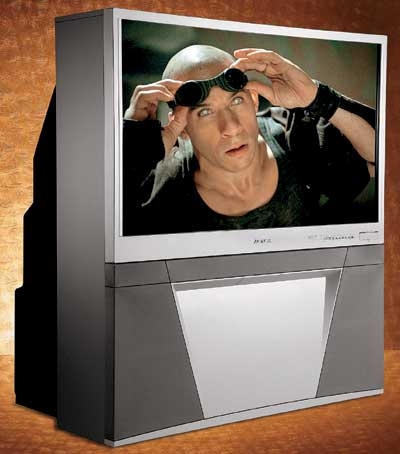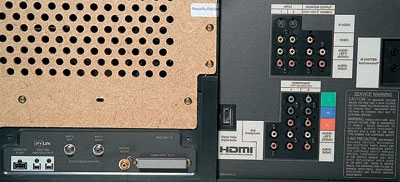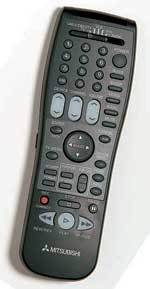Traditional Values Page 4
Mitsubishi has an extensive lineup of CRT-based rear-projection HDTVs, and the 48-inch WS-48515 is its smallest and best equipped. The screen has a protective shield, but it can be removed, which is good since it reflects quite a bit of room light. 
|
The back panel includes everything you'll likely need to connect present and future A/V gear and even boasts a pair of DTVLink (FireWire) ports so you can hook up, say, a D-VHS deck or a high-def hard-disk recorder. It also has a CableCARD slot. When you insert a compatible card from your cable company, you can tune digital and HDTV cable channels without an external box. During testing, the Mitsubishi's HDTV tuner grabbed fewer stations under difficult indoor conditions than either of the other two TVs in this group or our Dish satellite receiver.
I really appreciated the level of control over the picture the WS-48515 gave me. The TV can remember separate contrast, brightness, and other custom settings for each input. It also offers defeatable noise reduction and black enhancement as well as a set of PerfectColor controls that let you make unusually fine color adjustments. 
Like the other two TVs here (and unlike microdisplays), the Mitsubishi's picture looked washed out at very wide viewing angles. On the other hand, I was able to correct most fringing problems via the set's 64-point convergence control. Sure, it took more time to adjust than the Zenith or the RCA, both of which provide automatic convergence, but the results were obviously better.
When I slipped Riddick into the DVD player, I was again struck by the rich, deep blacks that tube technology affords. Shadow detail was also good, and with a relatively low brightness setting (to keep those deep blacks), I could still see the wrinkles and brownish tinge of Riddick's tunic.
 Although I'd calibrated the color temperature as close to the standard as I could (see "in the lab"), the darkest areas veered into bluish tones - which I couldn't fix without sacrificing the set's overall color balance. Still, the Mitsubishi did a fine job of conveying all the intricacies of the Necromongers' armor, from the tiny chain links in the neck pieces to the worn and dinged-up metal plates shaped into menacing faces.
Although I'd calibrated the color temperature as close to the standard as I could (see "in the lab"), the darkest areas veered into bluish tones - which I couldn't fix without sacrificing the set's overall color balance. Still, the Mitsubishi did a fine job of conveying all the intricacies of the Necromongers' armor, from the tiny chain links in the neck pieces to the worn and dinged-up metal plates shaped into menacing faces.
One of the set's main strengths is the PerfectColor menu mentioned earlier. While I wasn't able to get the color balance truly "perfect," the results were once again a huge improvement over the other two sets. After making this adjustment, I was able to increase color levels and lend extra realism to the whole palette. In the scene where Riddick meets Aereon, his bald head is splashed with reddish candlelight. The effect looked convincing and not too garish on his bronzed scalp, and Aereon's ghostly face and lipstick had just enough color to make her seem a bit human and friendly.
The Mitsubishi really came to life with high-def material. It provided the most detail of the three sets when it was fed 1080i-format HDTV programs. During the slow skyscraper pan at the beginning of the Digital Video Essentials montage section, I could make out the shapes of windows all the way to the very tops of the buildings. Details abounded in the neon of the Virgin Megastore sign and in the texture of a stone wall behind a scene of frolicking kids.
Colors looked equally spectacular in both this scene and the other HDTV programs that I watched. One kid's red tie and another's yellow hat looked vibrant. Even so, their somewhat flushed faces seemed realistic, not excessively ruddy.
All in all, the Mitsubishi's solid image quality and highly adjustable picture will make it a top choice if you're looking for a bargain on a full-feature HDTV.
PDF: Features Checklist PDF: In the LabAs television technology becomes increasingly diverse, there's a certain comfort in these three tube-based big-screen TVs. They use time-tested technology, and you'll never have to replace a lamp as in DLP or LCD rear-projection sets. Their screens are large enough to do real justice to high-def, and their deep blacks and shadow detail can make a movie really pop when the lights are turned low. The built-in HDTV tuners in all three sets mean you can get high-def for free as soon as you open the box. Sure, they're not the most glamorous sets in stores, if only because of their bulk, and they won't help you impress your football buddies with your knowledge of the latest TV jargon. But they'll get you into the high-def game for a price that's just right.
- Log in or register to post comments









































